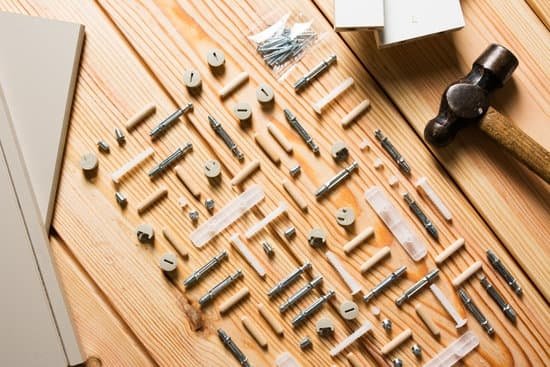What is a spline in woodworking? Woodworking is a versatile and rewarding craft that offers endless opportunities for creativity and craftsmanship.
When it comes to creating strong, secure joints in woodworking projects, understanding the role of splines is essential. In this article, we will explore the basics of joinery in woodworking, the purpose of splines, different types of splines used, how to create and install them, as well as the benefits and innovative ways of incorporating splines into your woodworking designs.
Woodworking involves working with wood to create functional and decorative items using a variety of tools and techniques. Joinery is an important aspect of woodworking that focuses on joining two or more pieces of wood together to create a sturdy structure. One method commonly used in joinery is the use of splines, which are thin strips of wood or other material inserted into grooves cut into the adjoining pieces to reinforce the joint.
Understanding the purpose and types of splines used in woodworking is crucial for achieving strong and durable joints in your projects. Whether you are a beginner or an experienced woodworker, learning about splines and their applications will enhance your skills and expand your creative possibilities in woodworking. Let’s delve into the world of splines and discover how they can elevate your woodworking projects to new heights.
The Basics of Joinery in Woodworking
Joinery is an essential aspect of woodworking that involves the joining together of different pieces of wood to create a sturdy and durable structure. There are several methods of joinery used in woodworking, each with its own unique benefits and applications. One such method is the use of splines, which play a crucial role in reinforcing joints and adding decorative elements to woodworking projects.
In woodworking, a spline refers to a thin strip of wood or other material that is inserted into a groove or slot cut into the surface of a board. The primary purpose of using splines is to strengthen the joint between two pieces of wood, particularly when creating butt joints or miter joints.
By adding a spline to these joints, woodworkers can improve the overall stability and strength of their projects, making them less susceptible to warping or splitting over time.
When it comes to creating and installing splines in woodworking projects, there are various techniques and tools that can be used to achieve the desired results. Woodworkers can choose from different types of splines, including straight splines, curved splines, and even contrasting materials such as metal or plastic.
The process typically involves cutting a groove or slot into the joint, cutting the spline to size, applying adhesive, and then inserting the spline into place before sanding it flush with the surface for a seamless finish. Understanding these fundamental aspects is crucial for achieving successful joinery in woodworking projects.
Understanding the Purpose of Splines
What Is a Spline in Woodworking?
In woodworking, a spline is a thin strip of wood that is inserted into a slot or groove to reinforce and strengthen joints, particularly in frames, boxes, and other woodworking projects. Splines are commonly used in joinery to add stability and durability to the overall structure of the project.
Importance of Splines
The primary purpose of using splines in woodworking is to improve the strength and stability of joints. By adding a spline to a joint, such as a mitered corner or butt joint, woodworkers can prevent the joint from separating over time due to changes in humidity or other environmental factors. This helps to ensure that the project maintains its structural integrity for years to come.
Enhancing Aesthetics With Splines
In addition to their functional benefits, splines can also enhance the visual appeal of woodworking projects. When crafted from contrasting wood species, splines can create eye-catching accents that add character and design interest to furniture pieces, picture frames, and more. This decorative element adds an extra level of craftsmanship and detail to the finished workpiece.
Understanding the purpose of splines in woodworking is essential for anyone looking to improve the strength, stability, and aesthetic appeal of their woodworking projects. Whether you are a beginner or seasoned woodworker, incorporating splines into your joinery techniques can take your craftsmanship to the next level.
Types of Splines Used in Woodworking
When it comes to woodworking, splines are a popular choice for joining two pieces of wood together. But what is a spline in woodworking? A spline is a thin strip of wood or metal that is inserted into a groove cut into the surface of the wood. This method strengthens and aligns the joint between two pieces of wood, providing added stability and durability. There are various types of splines used in woodworking, each with its own purpose and benefits.
One common type of spline used in woodworking is the simple rectangular strip. This type of spline is easy to create and install, making it a popular choice for many woodworkers. Another type of spline that is frequently used is the T-shaped spline, which provides increased strength and support to the joint. Additionally, there are also curved splines that can be used to add a decorative touch to woodworking projects.
In terms of materials, wooden splines are the most commonly used due to their compatibility with different types of wood and ease of creation. However, metal splines are also an option for specific woodworking projects where extra reinforcement is needed. Understanding the different types of splines available allows woodworkers to choose the most suitable option for their specific project needs.
| Type | Description |
|---|---|
| Rectangular Strip | Easy to create and install, providing basic support for joints. |
| T-shaped Spline | Offers increased strength and support to the joint. |
| Curved Spline | Adds a decorative touch while enhancing joint stability. |
How to Create and Install Splines in Woodworking Projects
In woodworking, a spline is a thin strip of wood that is inserted into a groove cut into two pieces of wood to join them together. This technique is commonly used to strengthen joints, add decorative accents, or align and level pieces of wood. Creating and installing splines in woodworking projects requires careful planning and precision to achieve the desired results.
Creating the Spline
To create a spline, you will need a piece of hardwood that matches the type of wood you are using for your project. The first step is to mill the spline material to the appropriate thickness and width. Next, using a table saw, cut a groove down the center of each piece of wood that needs to be joined. The depth of the groove should match the thickness of the spline material.
Installing the Spline
Once you have created the splines and prepared the grooves in your project pieces, it’s time to install them. Apply glue inside each groove before inserting the splines, ensuring that they fit snugly. Use clamps to press the pieces together until the glue dries, creating a strong bond between the joint and the spline. Once everything has dried and set, you can trim any excess spline material flush with the surface using a hand plane or chisel.
Tips for Success
When working with splines in woodworking projects, it’s essential to pay attention to detail and take your time to ensure accurate measurements and cuts. Additionally, choosing high-quality hardwood for your splines will result in stronger and more durable joints. Remember that precision is key when creating and installing splines in woodworking, as even minor errors can affect the overall quality and appearance of your project.
Benefits of Using Splines in Woodworking
When it comes to woodworking, using splines in your projects can offer a wide range of benefits. Whether you’re creating a simple picture frame or constructing a complex piece of furniture, incorporating splines into your woodworking design can enhance both the visual appeal and structural integrity of your work. Here are some key benefits of using splines in woodworking:
1. Strength and Stability: One of the primary advantages of using splines in woodworking is the added strength and stability they provide to joints. By inserting a spline into a joint, such as a miter or butt joint, you can significantly reinforce the connection between two pieces of wood. This added strength helps prevent joints from coming apart over time, making your woodworking projects more durable and long-lasting.
2. Decorative Accents: In addition to their structural benefits, splines can also serve as decorative accents in woodworking projects. When made from contrasting wood species or featuring unique patterns or designs, splines can add visual interest to corners, edges, or seams in your work. This allows you to elevate the overall aesthetic appeal of your woodworking creations while also showcasing your skills and attention to detail.
3. Versatility: Another advantage of using splines in woodworking is their versatility. Splines can be incorporated into various types of joints, including miters, butt joints, and even box joints, making them suitable for a wide range of woodworking applications. Additionally, with the use of specialized jigs and techniques, you can create different types of spline designs to complement different project styles and themes.
Innovative Ways to Incorporate Splines in Woodworking Designs
When it comes to woodworking, splines are not only functional but also add a decorative element to the design of a project. So, what is a spline in woodworking? In simple terms, a spline is a thin strip of wood that is inserted into a groove or slot in another piece of wood.
This technique is commonly used to reinforce joints and add strength to a project. However, splines can also be used creatively to enhance the visual appeal of woodworking designs.
One innovative way to incorporate splines in woodworking designs is by using contrasting wood species. By selecting a different type of wood for the spline, you can create an eye-catching contrast that adds an interesting detail to your project. For example, if you are working with a darker wood such as mahogany, consider using a lighter wood like maple for the spline to create a striking visual effect.
Another creative approach to incorporating splines in woodworking designs is by experimenting with different shapes and patterns. Instead of using traditional straight splines, try creating curved or angled splines for a unique look. Additionally, you can play around with various patterns such as herringbone or chevron, adding an element of complexity and artistry to your woodworking projects.
| Innovative Idea | Description |
|---|---|
| Contrasting Wood Species | Using different types of wood for the spline for added visual contrast |
| Experimenting with Shapes and Patterns | Creating curved or angled splines and playing with various patterns for unique designs |
Tips and Tricks for Working With Splines in Woodworking
When working with splines in woodworking, there are several tips and tricks that can help you achieve the best results. Here are some helpful pointers to keep in mind:
1. Choose the right material: When creating splines for your woodworking project, it’s important to choose a material that is strong and durable. Hardwood species such as oak, walnut, or maple are popular choices for creating splines due to their strength and visual appeal.
2. Use the right tools: To create precise and clean cuts for your splines, it’s essential to use the right tools. A table saw with a dado blade or a router with a straight bit can be used to cut the grooves for the splines, while a handsaw or miter saw can be used to cut the spline material itself.
3. Consider contrasting colors: For added visual interest, consider using a different wood species for your splines that contrasts with the main wood of your project. This can create a striking visual effect and add a unique touch to your woodworking design.
4. Pay attention to grain orientation: When cutting and installing splines, pay attention to the grain orientation of the spline material. Aligning the grain of the spline with the grain of the main wood will help ensure that it expands and contracts in unison with the rest of the project, reducing the risk of cracking or splitting over time.
5. Take your time with sanding: Once the splines are installed, take your time with sanding to ensure that they are flush with the surface of your woodworking project. Careful sanding will result in seamless transitions between the spline and main wood, creating a professional-looking finish.
By keeping these tips and tricks in mind when working with splines in woodworking projects, you can achieve high-quality results that enhance both the structural integrity and aesthetic appeal of your creations.
Conclusion and Final Thoughts on Using Splines in Woodworking
In conclusion, understanding what a spline is in woodworking can greatly expand your design and joinery options when working with wood. Splines are versatile and can be used in various ways to strengthen joints, add visual interest, and create unique designs. Whether you are a beginner or an experienced woodworker, incorporating splines into your projects can provide numerous benefits.
One of the key advantages of using splines in woodworking is the added strength they provide to joints. This is especially important for projects that will undergo a lot of wear and tear over time. Additionally, splines allow for more creative freedom when it comes to design. They can be used to add decorative accents, create patterns, or even combine different types of wood for a striking effect.
When working with splines in woodworking, it’s important to consider the type of spline, the tools needed for installation, and the best practices for creating clean and precise cuts. Taking the time to learn about these factors will ultimately lead to more successful and visually appealing results. Overall, exploring the use of splines in woodworking can open up new possibilities for creativity and craftsmanship in your projects.
Frequently Asked Questions
What Is a Spline Used for in Woodworking?
A spline in woodworking is a thin strip of wood that is used to reinforce joints or add decorative accents to a project. It is commonly used to strengthen miter joints, creating a stronger connection between two pieces of wood. Splines can also be used to create a visually appealing detail in projects like picture frames or table tops.
How Does a Spline Joint Work?
A spline joint works by inserting a thin strip of wood (the spline) into corresponding grooves cut into the two pieces of wood being joined together. This helps to strengthen the joint and prevent it from separating over time. The spline essentially adds surface area for glue to adhere to, resulting in a more secure connection between the two pieces.
What Is the Difference Between Splines and Keys in Woodworking?
The main difference between splines and keys in woodworking lies in their purpose and application. While both are used to reinforce joints, keys are typically used for joining boards edge-to-edge, whereas splines are often used for reinforcing miter joints or providing decorative elements.
Additionally, keys are often more visible on the finished piece, serving as an aesthetic element, while splines can be hidden within the joint for added strength without being as noticeable in the final project.

Hi everyone! I’m a woodworker and blogger, and this is my woodworking blog. In my blog, I share tips and tricks for woodworkers of all skill levels, as well as project ideas that you can try yourself.





